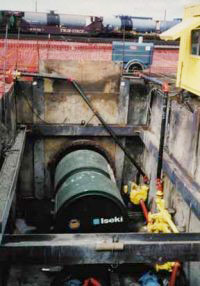
Wastewater is carried from homes and businesses by pipes and pump stations before
it's treated at wastewater treatment plants and released into Commencement Bay.
City of Tacoma Wastewater Management operates two treatment plants, cleans billions
of gallons of wastewater every year and serves hundreds of thousands of customers.
Learn more about how we move wastewater through the City.
Pump Stations
Pump stations move the wastewater flow from one area to another through sewer lines.
The City of Tacoma operates 50 pump stations. Help us keep the system flowing
by not flushing certain types of items. These items can cause pump stations
to fail, which can lead to sewer backups.
Tacoma's Treatment Plants
To serve our more than 90,000 customers, the City operates two award-winning
wastewater treatment plants -Central
Wastewater Treatment Plant and
North End Wastewater Treatment Plant.
Both treatment plants are considered state of the art, but operate in very different
ways. The
Central Wastewater Treatment Plant, located on the Tideflats along the Puyallup
River, uses high purity oxygen and "good" bacteria to remove organics from wastewater.
The
North End Wastewater Treatment Plant, in Mason Gulch off Ruston Way, uses chemicals
to remove the organics and a filter with "good" bacteria to treat the wastewater
before it enters Puget Sound.
Tours
Every year we lead hundreds of students (middle school through college)
and community groups through our wastewater treatment plants to show how they are
an integral part of recycling our resources and keeping our water clean. To set
up a group tour, call the Central Wastewater Treatment Plant at (253) 502-2176.
Improvement Projects
We're proud of Tacoma's historic buildings and appreciate when property owners
restore them, preserving the splendor of the old while adding the technology and
safety of today. While the wastewater system isn't as grand as our brick buildings
and historic homes, it's just as important for us to improve our infrastructure
to keep it operating safely and efficiently.
Some of our infrastructure is 100 years old and needs to be replaced. In the
past, we repaired pipes only when a failure occurred, but in 1995, the City began
an aggressive Inflow and Infiltration Program. At a cost of $4 million a year,
we began upgrading or replacing old sewer pipes that allowed groundwater and surface
water to seep into the sewer system through cracked and leaky joints.
To upgrade old sewer pipes, we use trenchless technology, allowing us in many cases
to replace pipes without cutting into the streets. This construction method
reduces time-consuming detours and costly road reconstruction.